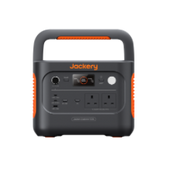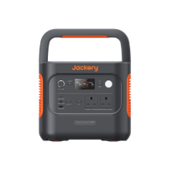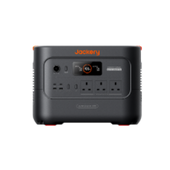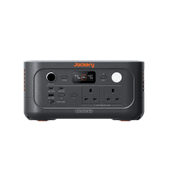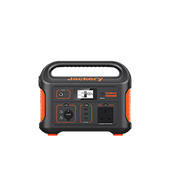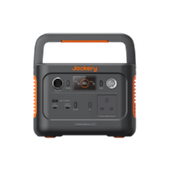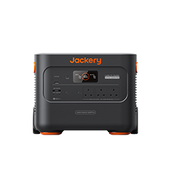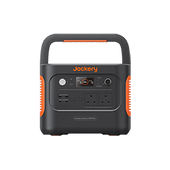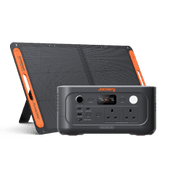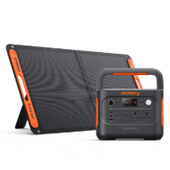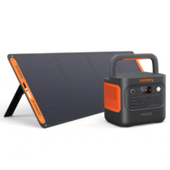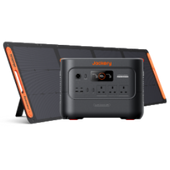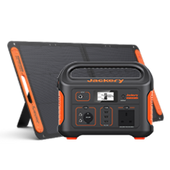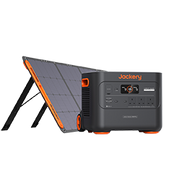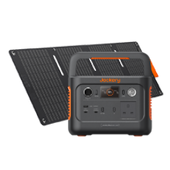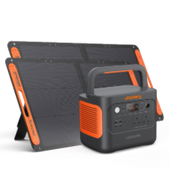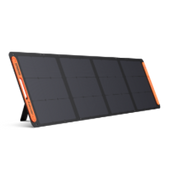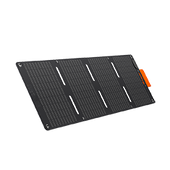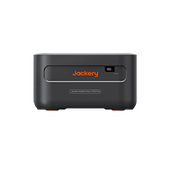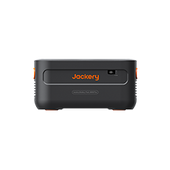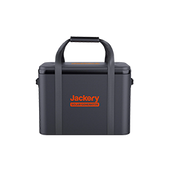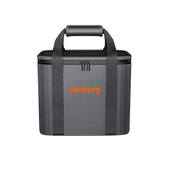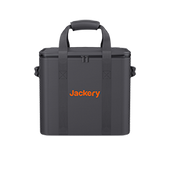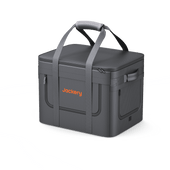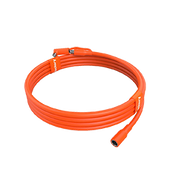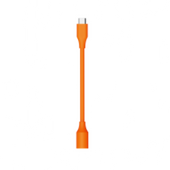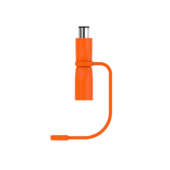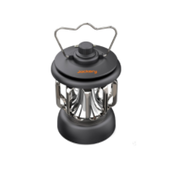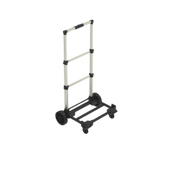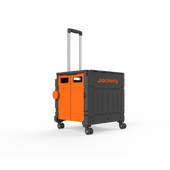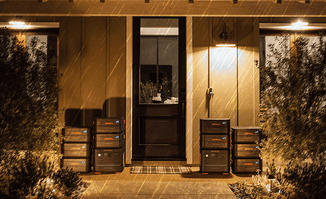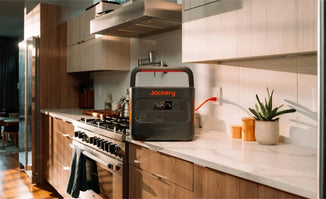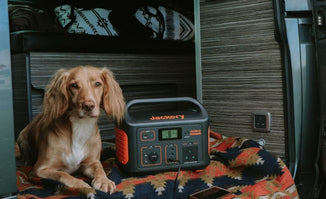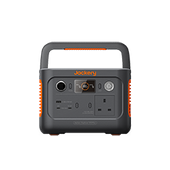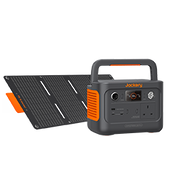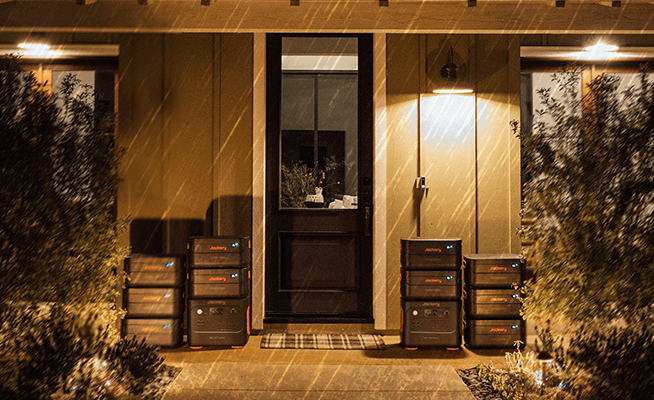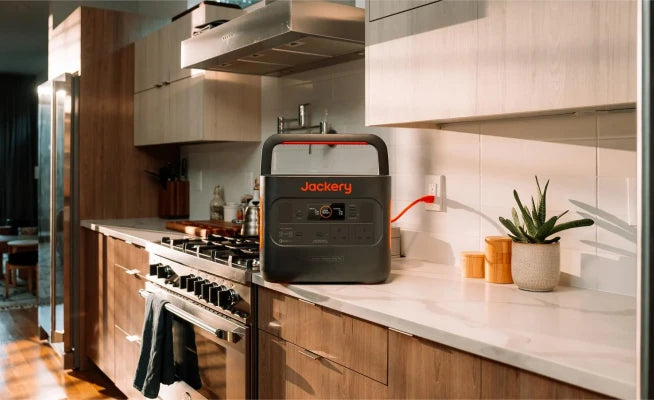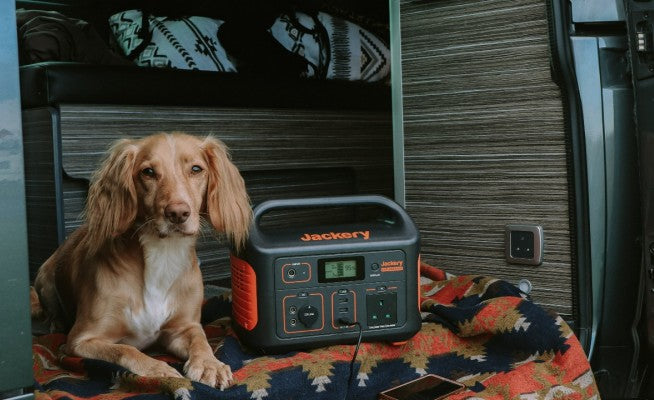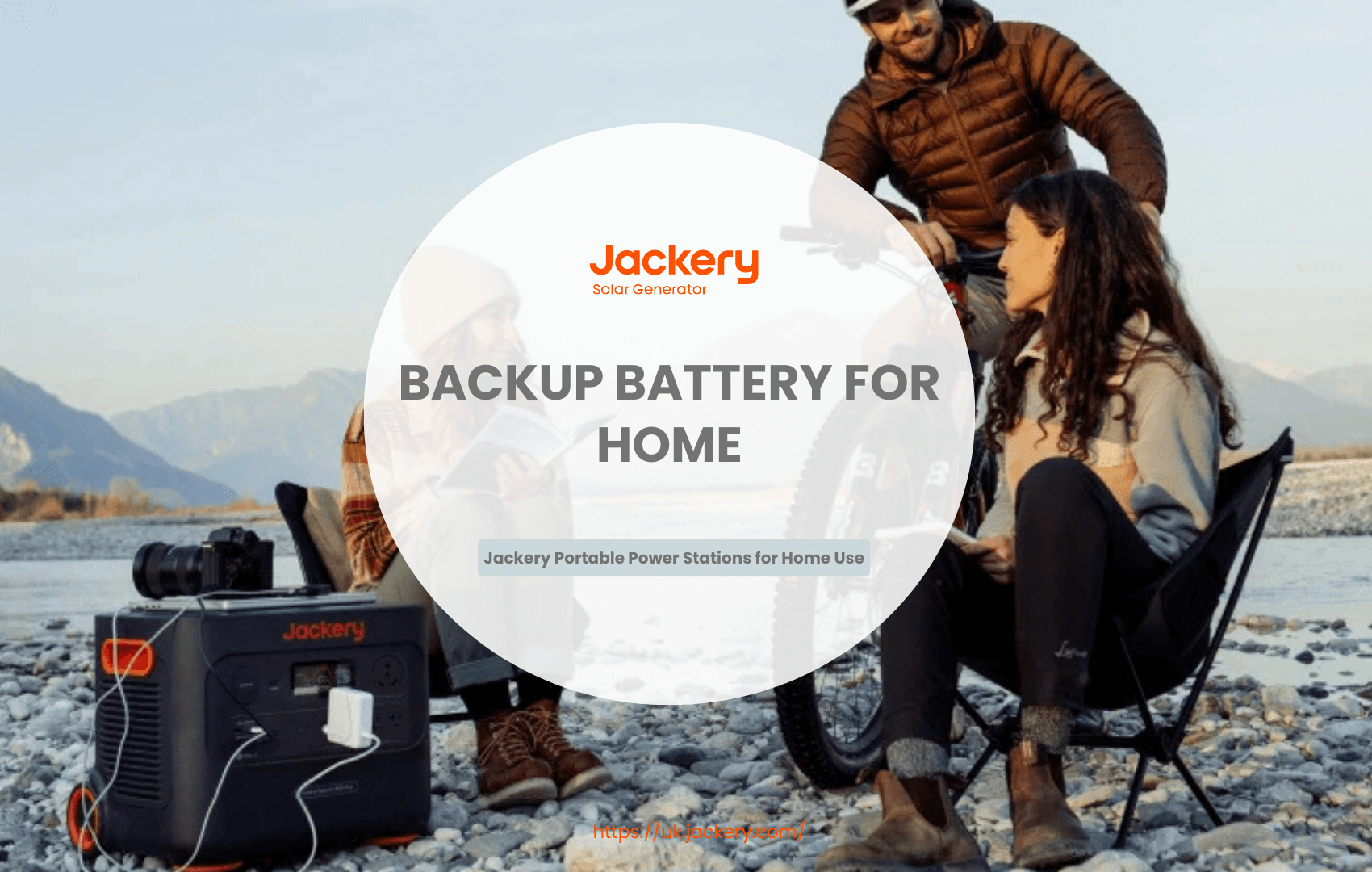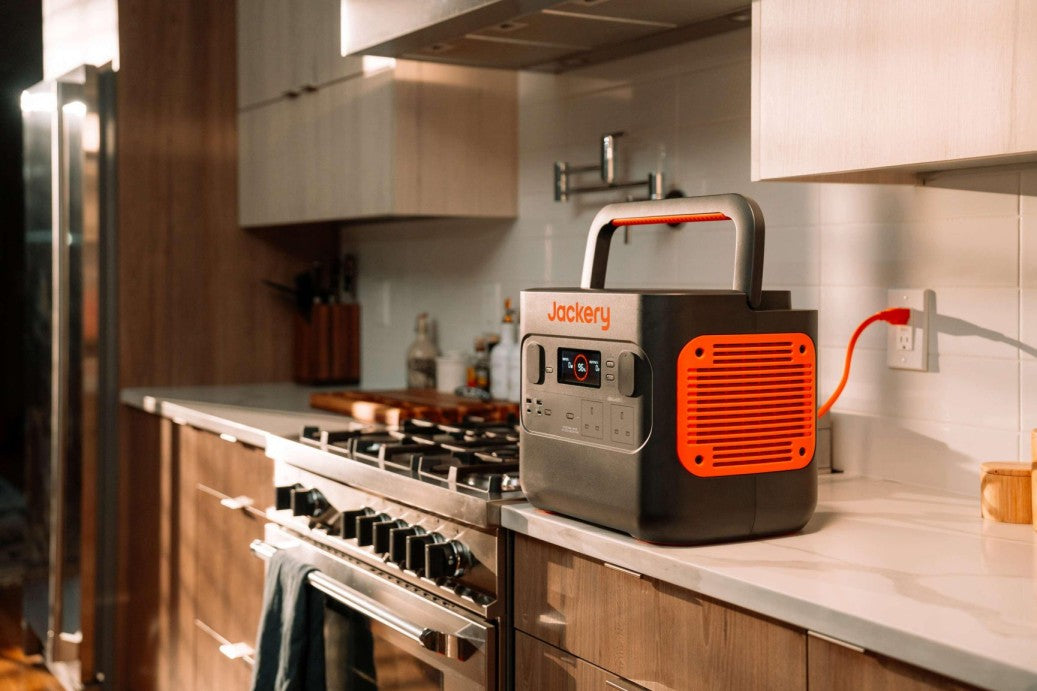In the UK, power outages are becoming more frequent, and many homeowners are turning to backup batteries for homes for reliable, uninterrupted power. Backup batteries for home not only protect your home during power outages, but they can also help you save on energy costs and reduce your environmental impact.
In this guide, we'll examine the basics of these backup batteries for your home, their types, and how to choose the best one. This guide also explores whether home backup batteries are suitable for UK homes.
You may think investing in backup batteries for your home is too expensive. In that case, you may consider having a Jackery Portable Power Station to charge essential household appliances in a power outage or emergency.
|
Key Takeaways: |
|
- Backup batteries for home provide convenience and safety to households in various scenarios. - Different types of backup batteries for the home have their advantages and disadvantages. Several critical factors must be considered when deciding whether a home backup battery is right for a UK household. - Power requirements and other factors must be assessed when choosing the correct backup battery for the home. - We recommend Jackery Explorer 1000 v2, 1000 Plus, or 2000 Plus to help your home or business operate smoothly and continually. - Proper installation and maintenance of a home's backup battery will ensure its safety and extend its life. |
What Are Backup Batteries for Homes
Backup batteries help during sudden power outages and provide convenience and safety for families in various scenarios.
Backup batteries for homes usually refer to an additional energy storage device that provides a temporary power supply when the power grid fails or is insufficient. In general, backup batteries for homes are an advanced energy storage solution that can provide backup power or supplement solar energy systems during power outages. Usually, home backup batteries are used in solar systems to store power generated by solar panels or power grids during off-peak hours, and they are discharged when needed to ensure an uninterrupted power supply to the home.
For families, backup batteries for the home can provide continuous power supply for key electronic devices such as lighting, communication equipment, refrigerators, etc., during power outages or power grid failures to ensure the regular operation of life.
How Do Backup Batteries Work?
When the main power supply (usually the power grid) is typically powered, the backup battery for the home is charged through the charger to keep it fully charged. Once the main power supply fails, the control system detects the power outage and quickly switches to the backup battery for the home power supply. The inverter can convert the power stored in the backup battery for the home into the AC power required by the device, thereby ensuring the device operates normally.
In short, the home backup battery can store the power of the home's primary power source (whether the public grid or solar panels) and save it until needed. For example, when a power outage occurs or the electricity bill soars, the backup battery will release the stored energy to provide uninterrupted power to your home.

Application Scenarios of Backup Batteries for Home
backup batteries for homes have a wide range of application scenarios in modern homes; from basic power security to the protection of high-tech equipment, they all play an indispensable role. Here are some of the main application scenarios of backup batteries for home:
- As a home backup power source
- Combined with solar power generation systems
- Support home network devices and monitoring systems
- For emergency response
- Protect high-value equipment
- Commercial power
- Outdoor power
Types of Backup Batteries for Home
With the advancement of technology and people's increasing dependence on electricity, backup batteries for home are particularly important in power outages or emergencies. Each type of backup battery for the house has advantages and is designed to meet different needs.
Backup batteries for home are generally of the following types:

Lead-acid Batteries
Lead-acid batteries are one of the older and more mature technologies in energy storage. As a result, they are widely used in automobiles and solar energy storage systems.
Lead-acid batteries are known for their affordability and durability, making them affordable for home systems' backup batteries. However, compared with other battery technologies, they have a lower energy density. In addition, lead-acid batteries contain hazardous materials and have a particular impact on the environment.
Nickel-cadmium Batteries
Lithium-ion batteries have largely replaced nickel-cadmium batteries. They are known for their durability and long cycle life, but they have a memory effect, and their adequate capacity will decrease over time. Although nickel-cadmium batteries have good resistance to overcharging and low temperatures, they contain toxic cadmium elements that harm the environment.
Lithium-ion Batteries
Lithium-ion batteries power various devices. As a result, they are widely considered the most efficient and durable choice for home use. However, they can be more expensive and require special care and maintenance.
LiFePO4 Batteries
LiFePO4 batteries are safe and suitable for home energy storage systems. They generally have longer cycle life and better resistance to temperature fluctuations than other lithium-ion battery chemistries. As a result, they are increasingly being used in energy storage systems and electric vehicles.
Flow Batteries
Flow batteries are also scalable, meaning they can be easily expanded to meet a home's changing energy needs. However, they are less common in residential settings due to their higher cost and complexity. Flow batteries are an excellent option for homeowners interested in advanced technology and scalability.
|
Battery Type |
Advantages |
Disadvantages |
|
Lead-acid Battery |
Low cost High recycling value Mature technology High-reliability |
Low energy density Short cycle life Environmental pollution risk Long charging time Memory effect |
|
Nickel-cadmium Battery |
Strong and durable Cheap Resistant to overcharge and over-discharge Stable performance Broad operating temperature range |
Memory effect Environmental pollution Small capacity Short life High self-discharge rate |
|
Lithium-ion Battery |
High energy density Long cycle life No memory effect Safe and environmentally friendly Fast charging speed Wide operating temperature range |
High cost Intolerant to overcharge Capacity decay Difficult to recycle |
|
LiFePO4 Battery |
High-safety Long cycle life Environmentally friendly High energy density Fast charging Wide temperature range |
High initial cost Low voltage platform Requires dedicated charger |
|
Flow Battery |
High capacity and flexibility High safety Environmentally friendly Quick response |
Higher cost Large volume Complex electrolyte management
|
Are Backup Battery for Home Suitable for UK Households?
Backup batteries for the home can ensure an uninterrupted power supply in emergencies, protecting valuable electronic devices, appliances, and data. They can also improve energy security during extreme weather conditions or natural disasters.
Therefore, home backup batteries have become an indispensable part of many households. So, are backup batteries for a home suitable for British households? For many British households, there are several factors to consider when evaluating whether to use backup batteries for home:

- Electricity Demand in the UK
Household electricity demand in the UK is similar to that in many other countries, mainly for lighting, heating, cooling, cooking, and entertainment. However, the UK's climatic conditions, especially the cold winters and cool summers, make heating equipment (electric heaters and hot water systems) central to household electricity consumption.
- Suitability of Backup Batteries for Home in the UK
Please evaluate the frequency and duration of power outages in your area and consider the local power grid's stability and the impact on your home electricity consumption. Although the power supply in the UK is relatively stable, unpredictable weather and occasional power supply interruptions may still affect family life. Secondly, for UK households living in rural or remote areas, backup batteries for homes can provide an extra layer of security.
- Local Utility Policies in the UK
Local utility policies significantly impact whether most UK people choose backup batteries for their homes. Please check with your local utility company for potential incentives or special schemes for backup batteries.
There needs to be incentives and subsidies specifically for backup batteries for homes in the UK. But here are some of the relevant subsidies that you can currently benefit from in the UK:
- If you have a mortgage with Barclays, Halifax or Lloyds, you may be able to get a £1,000 cashback after installing a battery. (Green Homes Incentive Scheme)
- From 1 February 2024, battery storage has now enjoyed the same 0% VAT rate as solar panel installations. (Will last until 31 March 2027)
- ECO4 and the Home Upgrade Grant (HUG) fund energy suppliers and local authorities to make energy-saving improvements for low-income, vulnerable households.
- Pros & Cons of Backup Batteries for Home
Backup batteries for home could be better, but they have both advantages and disadvantages. When considering whether to need backup batteries for home, British families need to consider their advantages and disadvantages in addition to the above considerations. The following is an analysis of the advantages and disadvantages of backup batteries for home:
|
Pros & Cons of Backup Batteries for Home |
|
|
Pros: More stable power supply High safety Low-maintenance or maintenance-free Convenient to use and efficient management Environmental protection and energy saving To a certain extent, off-the-grid Reduce some electricity bills |
Cons: High initial investment Capacity limitation Long charging time Lifespan issues |
In summary, home backup batteries have significant advantages in providing power supply stability, safety, easy maintenance, environmental protection, and energy savings. Still, they also have disadvantages, such as a high initial investment, capacity limitation, long charging time, and lifespan issues.
In short, when considering whether backup batteries for the home are suitable for British families, please consider your own needs and the advantages and disadvantages of backup batteries.
If you think backup batteries may cost too much for your home, investing in a portable power station is also suitable for home use as a backup power supply to ensure that crucial equipment can operate normally. Jackery Explorer 2000 Plus, 1000 v2, and 1000 Plus are good options for charging essential appliances in power outages or emergencies with over 12 kWh capacity.
Jackery Portable Power Stations for Home Uses
The expense of batteries and inverters might be excessive for most homeowners. House batteries pose a fire hazard; therefore, installing smoke detectors and maintaining proximity to a fire extinguisher is essential. Battery backup inverters may lack the capacity to initiate and operate substantial appliances such as electric vehicle chargers.
So, a portable power station is another good choice for charging certain household appliances in emergencies or power outages. Jackery Portable Power Stations are practical power sources that offer electricity from 99Wh to 12 kWh, which is enough for several appliances and devices at home.
The lithium-ion and LiFePO4 batteries inside the Jackery Portable Power Stations make them last longer and more durable; some can last over 10 years. With our battery protection technology, you can safely use power stations indoors. Here, we recommend the Jackery Explorer 1000 v2, 1000 Plus, and 2000 Plus.

Jackery Explorer 1000 v2
The Explorer 1000 v2 Portable Power Station delivers a remarkable 1500W output, which is 50% higher than previous models and ideal for short-term power cuts. If you need a portable compact power supply for power cuts or other emergencies in your home, this one could be your first choice!
It can effectively power high-demand items like refrigerators, televisions, and portable air conditioners. Featuring USB-A/C ports and dual PD charging capabilities of up to 100W, it can concurrently charge several devices (such as a phone and laptop), making it an optimal companion during power outages or emergencies.
The Emergency Charge Mode, initiated using the app, allows the Explorer 1000 v2 Portable Power Station to attain a complete charge in less than one hour, offering crucial power support when the battery is exhausted. Furthermore, charging from 0% to 100% in two hours using an AC wall outlet enhances battery lifespan.
Enjoy tranquilly with its almost silent functionality, keeping noise levels around 22dB while powering your devices.

Jackery Explorer 1000 Plus
The Explorer 1000 Plus power station boasts an excellent 1264Wh long-lasting LiFePO4 battery and a 2000W full-power pure sine wave inverter, supplying the required power for your home. Adding up to three additional battery packs will remarkably increase its capacity to 5kWh.
Adding up to three extra battery packs lets Jackery's exclusive technology boost the Explorer 1000 Plus capacity from 1.26kWh to 5kWh. Moreover, it has a maximum output of 2000W, 20% more than usual 1kWh LFP generators.
The MPPT technique guarantees 99% efficiency in solar charging. A wall charge from 0% to 100% of the battery requires 100 minutes, whereas solar charging with four SolarSaga 200W solar panels necessitates 2 hours. With car charging capabilities, concerns over power disruptions will be alleviated.

Jackery Explorer 2000 Plus
The Jackery Explorer 2000 Plus represents a significant technological advancement in portable power stations. It employs a LiFePO4 battery to achieve expandable capacity, providing 2 to 12 kWh of electricity to power essential appliances during an emergency or power outage.
The Jackery Explorer 2000 Plus boasts an impressive output of 3000W, offering 30% more rated power than other 2 kWh solar goods. ChargeShield is Jackery's sophisticated rapid charging technology, incorporating 62 protective mechanisms, 12 protective algorithms, and four categories of physical safety measures.
This technique employs a distinctive stepped variable-speed charging algorithm to improve safety and prolong battery pack longevity by 50%. The Explorer 2000 Plus can also be recharged efficiently using SolarSaga 200W solar panels in 2 hours, a wall outlet in 1.7 hours, and a carport in 25 hours.

How to Choose a Suitable Backup Battery for Home?
Evaluating your power needs, specific requirements, and other factors is essential when choosing the correct backup battery for your home.
- Battery Capacity
To evaluate the correct battery size, consider your home's average daily power usage and the hours you want your backup battery to run.
Here are the steps to calculate the correct backup battery for home capacity:
Step 1: Evaluate Your Power Needs
Make a detailed list of essential appliances that must be powered during a power outage (including refrigerators, lights, sump pumps, heating/cooling systems, and communications equipment) and their power ratings. Estimate how long you need these appliances to run during a power outage or other situations. For example, consider whether you need short-term backup (a few hours) or long-term backup (a few days).
Step 2: Determine Battery Capacity
Multiply the total wattage by the number of hours of run time required, and you will get the kilowatt-hours (kWh) you need to power your essential appliances during a power outage.
Battery capacity (kWh) = Total device power (W) × Run time (h)
- For example, if you want to run a 1,000-watt refrigerator and a 500-watt oven for 6 hours, how big a backup battery for home do you need?
- (1,000W + 500W) * 6 hours = 9 kWh
If you want to run a 1,000-watt refrigerator and a 500-watt oven for 6 hours, you will need a 9 kWh backup battery for home.
- Lifespan
The lifespan of a home backup battery is an essential factor to consider, as it determines how long your investment will last. The lifespan of a home backup battery will vary depending on the technology, quality, and usage patterns. To estimate the expected lifespan of a battery, check the manufacturer's specifications.
- Brands and Reviews
Choosing a home backup battery from a reputable brand will ensure its quality and reliability. Customer reviews and ratings should also be checked to gauge user satisfaction and experience.
- Warranty
A solid warranty ensures protection against defects or malfunctions, while good customer support ensures help if anything does happen. Please consider the warranty length, what's covered (such as parts and labour), and any conditions or exclusions that may apply.
Installation and Maintenance of Backup Battery for Home
The correct installation and maintenance of home backup batteries are crucial, whether used for emergency lighting, powering appliances, or security systems. This section will detail the installation steps and daily maintenance methods of home backup batteries to ensure their safety and extend their service life.
Installation of Backup Batteries for Home
Planning and preparation are essential before installing a solar battery backup system. The correct installation of backup batteries for the home is related to safety during use.
You must work with a licensed electrician when installing a home battery backup system. They will ensure that your system meets all safety standards. Then, the electrician will generally follow the steps below for the correct installation of backup batteries for the home:
Step 1: Place the battery in the designated battery box or bracket.
Step 2: Use appropriate wires to connect the battery's positive and negative poles.
Step 3: Install the battery in a suitable location. (Please ensure the installation environment is dry and ventilated and avoid high temperatures and direct sunlight.)
Step 4: Connect the battery to the home's distribution board through a transfer switch or power input. Connect the battery to a solar panel or other charging source if applicable.
Step 5: After completing the connection, check the total battery system voltage and single-cell open circuit voltage values to ensure the wiring is correct.
Maintenance of Backup Batteries for Home
Maintenance is essential for home backup batteries to ensure that they can be used for a long time and perform optimally during power outages. To keep backup batteries for the home running seamlessly, follow these maintenance tips:
Regular Inspection: Regularly check the appearance of the home's backup battery for damage, leakage, etc., and check whether the connection wires are firm and corroded.
To avoid overheating, check whether the area where the backup battery for the home is located is well-ventilated.
Cleaning and Maintenance: Clean the surface of the backup battery for the home regularly and keep the battery terminals clean and dry. If oxidation is found on the terminals, they can be cleaned with soda water.
Charging and Discharging Management: Depending on the type and use of the home backup battery, charge and discharge it regularly. Even if it is not used frequently, ensure the backup battery is charged to at least 50-80% every three to six months.
Temperature Management: Home backup batteries are best within a specific temperature range. Keep them away from extremely hot or cold temperatures. In addition, backup batteries that are not used for a long time should be stored in a dry and cool environment.
Backup Battery for Home FAQs
The following are the frequently asked questions about the backup battery for homes in the UK:
- How big of a battery do you need to power a house?
In the UK, most homes have an average of 1-3 bedrooms, and an 8kWh battery might be enough to cover basic electricity needs. To assess the correct battery size for your needs, consider your home's average daily electricity usage and the hours you want your home's backup battery to run. Estimate a rough backup battery for home capacity in two simple steps:
Step 1: Assess your power needs
List the power ratings of the essential appliances you need to power during a power outage and their run times.
Step 2: Calculate battery capacity
Multiply the total wattage by the number of run hours required, and you'll have the kilowatt-hours (kWh) you'll need to power your essential devices during a power outage.
- How much does a backup battery cost for a home?
Backup battery prices for home appliances vary widely based on capacity, brand, and features. Several factors determine the cost of a home backup battery, including the type and capacity of the battery selected. For example, higher-capacity battery storage units are generally more expensive.
Choosing a different battery storage solution, such as lithium-ion or lead-acid, can also affect the overall expense. Additionally, installing and maintaining a backup battery for the home also plays a significant role in overall pricing.
The following chart is a reference cost of different types of backup batteries for home:
|
Battery Type |
Average Cost |
Capacity |
Lifespan |
|
Lithium-ion |
£7,000-15,000 |
10-15 kWh |
10-15 Years |
|
LiFePO4 |
£8,000-15,000 |
10-16 kWh |
10-20 Years |
|
Lead-Acid |
£2,000-5,000 |
5-10 kWh |
3-7 Years |
|
Saltwater |
£8,000-12,000 |
9-10 kWh |
10-15 Years |
- How long will a whole house battery backup last?
The power supply time of a home's backup battery depends on the energy consumption of the household appliances.
Typically, a 10-15 kWh battery will power you for at least 24 hours if you only use essential appliances. However, combining multiple batteries or choosing a higher capacity option can significantly increase this duration.
Final Thoughts
Backup batteries for homes offer homeowners a reliable and sustainable solution to maintain power during power outages and reduce reliance on the grid. However, whether a backup battery for your home is suitable for your home in the UK is a decision that requires assessing your power needs, considering the type of battery, setting a realistic budget, and seeking professional advice.



